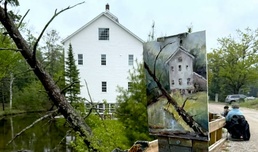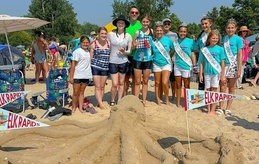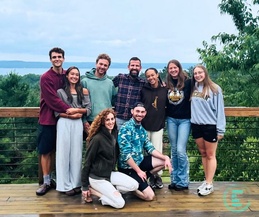The Treasure Hunter
Sept. 5, 2007
He’s alone, the man who stares into the camera; so tired, you can feel his exhaustion through the screen. The sand behind him, lit by two tiki torches and spiked with dried brush, is barren and uninviting. Bedraggled, unshaven, and thin, he speaks in a hoarse voice, gesturing to an encrusted item; an artifact, he explains, found in the remains of a Spanish galleon. The next item he wearily holds up to the camera has a familiar hue. “This, gentlemen...I don’t have to tell you what this is...”, the man’s tone, still tired, brightens. The item he’s referring to is a Spanish gold ingot. Mined in what was called the New World in the times the Spanish held dominion there hundreds of years ago, and lost to the sea in a shipwreck, the ingot was merely a part of the Caribbean’s massive underwater graveyard...until now.INSPIRATION FROM THE OCEAN
The man in the video is Steve Hoyt, a professional scuba diver, businessman and treasure hunter. The video is one he filmed on the beach of a sparsely populated island in the Caribbean to show prospective investors his new company, recently established with an office in Traverse City. The West Indies Salvage Company is the culmination of a dream that Steve has been pursuing for many years now; to salvage wrecks off the reefs and shores of the British Virgin Islands. Now, together with investors Hank Ransby, Roger Wares and Aubrey Levens, Steve is pursuing his vision with more determination than ever. The West Indies Salvage Company has obtained rights to dive and salvage wrecks in the bays and reefs of selected areas of the British Virgin Islands, and Steve will be offering recreational diving experiences to those who wish to dive the wrecks through a dive shop he built himself in the area, and through a website on the Internet.
TURNING POINT
It’s been a long road to get to this point. Steve’s journey began thousands of miles from the islands of the Caribbean, in front of a television set in Northern Michigan in the 1970’s, watching episodes of the undersea world of Jacques Cousteau. Cousteau seemed superhuman to Hoyt, and his voyages into the seemingly alien undersea world left an indelible mark. Later, on a trip to Florida, Steve took diving lessons and visited the shipwreck museum of Mel Fisher, a legendary diver and treasure hunter. The trip was a turning point, Steve says, “...right then and there it was like I had caught the bug. I mean, it was the fascination with the old shipwrecks and the artifacts; not just the silver and gold but the artifacts themselves, the old cutlass and the old muskets. Everything that was on an old ship just completely fascinated me. And that’s kind of where it all began.”
KEEPING THE DIVE ALIVE
Following the inspiration that Mel and other treasure hunting legends like Kip Wagner gave him, Steve continued diving and began researching shipwreck history. In the mid ’80s, after his applications were turned down at the Seattle Institute of Diving, Steve decided to make a pilgrimage in person to the prestigious dive school, camping out in the parking lot in a ’77 Pinto until he was finally admitted. After graduating, he worked as a hardhat diver in the Mississippi and Ohio rivers for years before starting his own construction business in Michigan, and settling down to start a family. Diving was put on the back burner, but was never far from his mind.
He kept up casual research into the great treasure hunters, reading about the discovery of the 1715 fleet off the coast of Florida by Kip Wagner, and Mel Fisher’s discovery of the Atocia and Santa Margarita. The stories gave him inspiration; the men’s accomplishments were daunting, but they also showed that the dream was attainable. Steve says of the time, “I studied these guys and watched what they did for years and years, their every move literally, you know, and finally just told myself: you could do this – these guys are made from the same cloth as you – there’s no extraordinary talent that they have that I didn’t have.”
THE CARIBBEAN CALLS
The seafaring history of the Caribbean began with Columbus, who heralded a dark era of exploitation for the so-called New World. The islands of the Caribbean were a stopover for many ships heavily laden with gold, silver, and jewels pilfered from the Americas to feed European greed. In the 1600’s, mining operations in South America and Mexico, governed by Europeans and worked by slaves brought from Africa, produced enough gold and silver to accelerate inflation in the European economy. The islands of the Caribbean were a regular port for convoys carrying the precious metals. Over 28,000 ships - a whopping 30% - are documented to have been lost in the area, and there are quite likely many more lost that were undocumented. The wrecks are down there in the graveyard, Steve reasons, waiting to be discovered.
First drawn to the Caribbean by the desire to excavate the sunken city of Port Royal, a pirate city which sunk into the sea nearly intact in a huge earthquake in the 1600’s, Steve instead chose another island – a small, lesser known one – then reachable only by bush plane. He lived there on the beach in thatched huts for eight months, diving off the shore and finding artifacts and ballast stones from ancient ships. Across the coral paved roads of an island community that only recently had been introduced to electricity, Steve made contact with the island inhabitants, discovering their exceptional, rustic community. A different spirit prevails there. Steve’s business partner Aubrey Levens, whom Steve describes as the unofficial mayor of the island, sums it up like this: “People come here to feel the power of freedom, what it is to be free. Nobody does anything down here but try to take care of each other.” In this setting, still off the beaten path of most tourists and recreational divers, Steve has already discovered three ancient shipwrecks; he has asked that the name of the island not be revealed in this article.
JOLLY ROGER REDUX
A wild man who often sports a grizzly beard together with a Jolly Roger tattoo, and who greets friends new and old with a friendly pirate “Arrrrhhh!”, Steve wouldn’t be out of place crewing one of the ancient shipwrecks he’s working to salvage. It’s clear the pirate spirit is alive here. Steve is a believer in ghosts, and it’s possible the ghosts of the great pirates of the golden age whisper a few words in his ear now and then – men like Edward Teach, better known as Blackbeard; Bartholomew Roberts; Henry Morgan; and the scores of other Privateers and Freebooters whose cutlasses and cannons terrified gold convoys off the Spanish main. Their spirit is integral to Steve’s quest. Profit is a motive, but the driving force behind his endeavors is still the fascination with the wild days of the Caribbean.
The preservation and proper excavation of artifacts found is a priority; the dive shop that replaces the improvised tiki hut is only the beginning, as plans are in the works to build a museum to house artifacts that are recovered. Recovery and salvage of wrecks that are found will take time, as the artifacts are often replaced until grids can be established in order to correctly document a site. “It literally takes decades to properly document, catalog and excavate a shipwreck,” Steve says. “It’s not an overnight thing. People have this idea that you’ll go down there and you’ll find a treasure chest. It’s not like that. What happens is that these ships...not in all cases but the majority of them... are caught in a hurricane or a violent storm, and they’re run up on a reef. At that point what happens is the ship is completely ripped apart and then spread over miles in underwater debris piles. Its not like you go down there and see a skeleton on a ship wheel and a treasure chest out to the side there.”
A PIRATE’S LIFE
It is clear that Steve hopes to create a legacy that will be passed on. A glimmer shines in his eye as he talks about his son, Zach, and the three and a half months they spent together on the island, on a recent treasure-hunting trip. Steve is a man who seeks to make his mark, to establish a legacy, for his children and for future generations who will, if he is successful, view artifacts he has discovered in museums he has built. History and luck will define Steve’s quest, as it did the mariners whose wrecked ships he excavates. The road ahead is long. “The dream needs to be bigger than the struggle,” Steve said. The treasure is there for those who would find it, together with the old bones of someone who used to hold it dear. There may not be a skeleton at a ship wheel, beckoning like old Ahab from a watery grave, but there might be a whisper of a ghostly “Arrrrhh!”
Trending

The Art of Summer: 15+ Exhibits, Fairs, and Workshops in August
Northern Michigan comes alive in the summer, and so does its art scene. From shoreline towns to downtown galleries, creativi… Read More >>
Street Sale + Friday Night Live
TC’s biggest summer street party returns! The Downtown Street Sale and Friday Night Live are joining forces Friday, Au… Read More >>
Harbor Days Are Here!
The biggest Elk Rapids bash returns July 30-Aug. 2 for its 70th year. Opening ceremonies take place on Wednesday, paired wit… Read More >>


